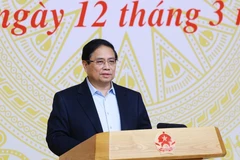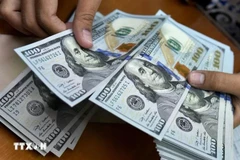 During 2011-2015, Vietnam began to adjust its policies in the direction of promoting economic restructuring and changing the growth model for rapid and sustainable growth. (Source: VNA)
During 2011-2015, Vietnam began to adjust its policies in the direction of promoting economic restructuring and changing the growth model for rapid and sustainable growth. (Source: VNA) Hanoi (VNA) – Vietnam’s economicrestructuring and growth model reform in 2016-2020 have been benefiting frompositive changes in policies and achievements in the 2011-2015 period,according to economist Nguyen Dinh Cung.
The former Director of the Central Institutefor Economic Management (CIEM) made the remark at a workshop in Hanoi onSeptember 17 to announce the CIEM’s report reviewing the outcomes ofrestructuring the economy and reforming the growth model in 2016-2020. Theevent was within the framework of the Australia Supports Economic Reformin Vietnam (Aus4Reform) programme.
The report looked at macro economic stability and the economy’sresilience, growth and growth quality, and restructuring of investment, creditorganisations and State-owned enterprises.
Cung noted that during 2011-2015, Vietnam beganto adjust its policies in the direction of promoting economic restructuring andchanging the growth model for rapid and sustainable growth.
Accordingly, macro policies were graduallytightened with flexible adjustment to stabilize the macro economy, while aseries of pgorammes and projects were carried out to shift the growth modeltowards higher quality, greater efficiency and better competitiveness.
The 2016-2020 tenure saw more favourableconditions thanks to the policy adjustment in the previous term. During theterm, Vietnam has kept the inflation rate at a reasonable level of under 4percent. The State budget collection has been significantly improved. However,State budget expenditure remained high, accounting for nearly 29 percent of thegross domestic product (GDP).
Besides, public debts and foreign debts havebeen decreased, Cung said, adding that those debts are still at a high levelcompared to other countries in the region.
He attributed those positive outcomes to theshift of focus in economic reform and administration of socio-economicdevelopment since 2011.
In the period, the country focused its effortsand resources on stabilising the macro economy and restoring businessproduction, thus creating a new momentum which was strong enough to mobilisemore social resources, allocate and use them more effectively, and graduallyform a more rational and dynamic economic structure, Cung said.
However, he also pointed to the need to reduce theeconomy’s dependence on foreign direct investment (FDI) enterprises.
Addressing this imbalance does not mean limitingor constraining foreign investment but instead helping the domestic privateeconomic sector develop at a faster and more even speed, he said.
Besides, it is necessary to forge connectionbetween economic sectors, he suggested./.




























